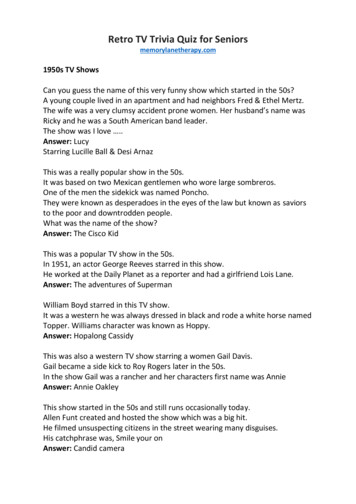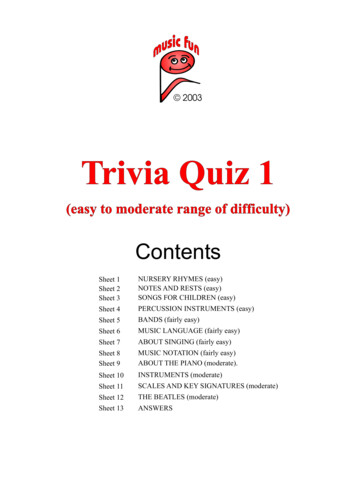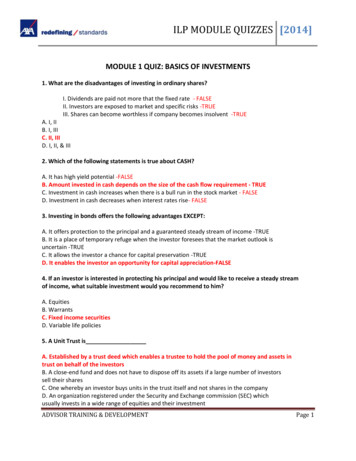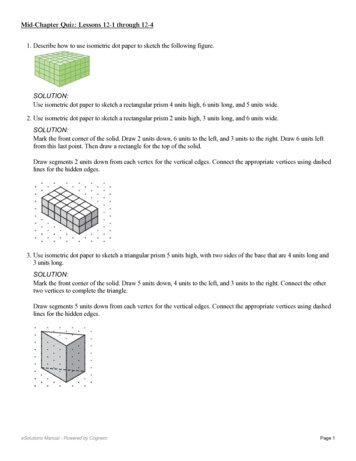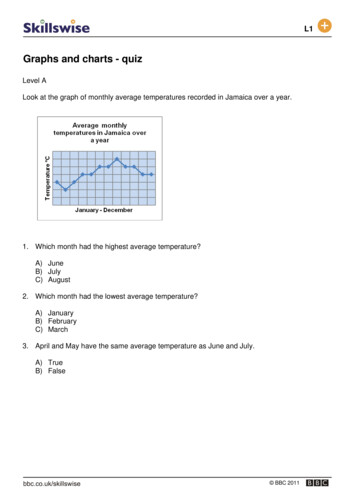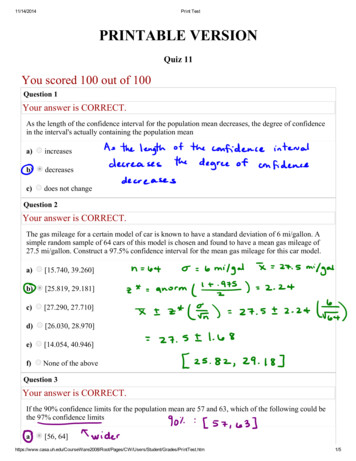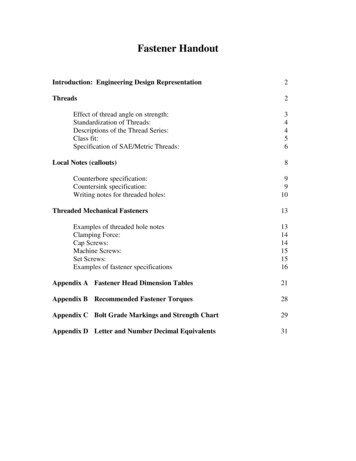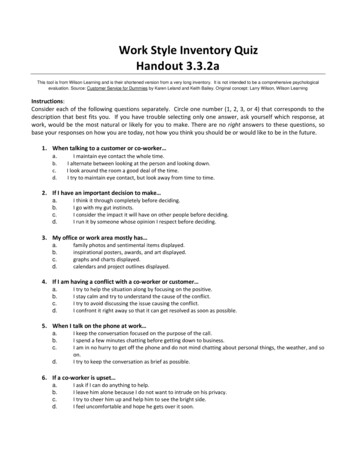
Transcription
Work Style Inventory QuizHandout 3.3.2aThis tool is from Wilson Learning and is their shortened version from a very long inventory. It is not intended to be a comprehensive psychologicalevaluation. Source: Customer Service for Dummies by Karen Leland and Keith Bailey. Original concept: Larry Wilson, Wilson LearningInstructions:Consider each of the following questions separately. Circle one number (1, 2, 3, or 4) that corresponds to thedescription that best fits you. If you have trouble selecting only one answer, ask yourself which response, atwork, would be the most natural or likely for you to make. There are no right answers to these questions, sobase your responses on how you are today, not how you think you should be or would like to be in the future.1. When talking to a customer or co-worker a.I maintain eye contact the whole time.b.c.d.I alternate between looking at the person and looking down.I look around the room a good deal of the time.I try to maintain eye contact, but look away from time to time.2. If I have an important decision to make a.b.c.d.I think it through completely before deciding.I go with my gut instincts.I consider the impact it will have on other people before deciding.I run it by someone whose opinion I respect before deciding.3. My office or work area mostly has a.b.c.d.family photos and sentimental items displayed.inspirational posters, awards, and art displayed.graphs and charts displayed.calendars and project outlines displayed.4. If I am having a conflict with a co-worker or customer a.b.c.d.I try to help the situation along by focusing on the positive.I stay calm and try to understand the cause of the conflict.I try to avoid discussing the issue causing the conflict.I confront it right away so that it can get resolved as soon as possible.5. When I talk on the phone at work a.b.c.d.I keep the conversation focused on the purpose of the call.I spend a few minutes chatting before getting down to business.I am in no hurry to get off the phone and do not mind chatting about personal things, the weather, and soon.I try to keep the conversation as brief as possible.6. If a co-worker is upset a.b.c.d.I ask if I can do anything to help.I leave him alone because I do not want to intrude on his privacy.I try to cheer him up and help him to see the bright side.I feel uncomfortable and hope he gets over it soon.
7. When I attend meetings at work a.I sit back and think about what is being said before offering my opinion.b.I put all my cards on the table so my opinion is well known.c.I express my opinion enthusiastically, but listen to others’ ideas as well.d.I try to support the ideas of the other people in the meeting.8. When I make a presentation in front of a group a.I am entertaining and often humorous.b.I am clear and concise.c.I speak relatively quietly.d.I am direct, specific, and sometimes loud.9. When a customer is explaining a problem to me a.I try to understand and empathize with how she is feeling.b.I look for the specific facts pertaining to the situation.c.I listen carefully for the main issue so that I can find a solution.d.I use body language and tone of voice to show him/her that Iunderstand.10. When I attend training programs or presentations a.I get bored if the person moves too slowly.b.I try to be supportive of the speaker, knowing how hard the job is.c.I want it to be entertaining as well as informative.d.I look for the logic behind what the speaker is saying.11. When I want to get my point across to customers or co-workers a.I listen to their point of view first and then express my ideas gently.b.I strongly state my opinion so that they know where I stand.c.I try to persuade them without being too forceful.d.I explain the thinking and logic behind what I am saying.12. When I am late for a meeting or appointment a.I do not panic but call ahead to say that I will be a few minutes late.b.I feel bad about keeping the other person waiting.c.I get very upset and rush to get there as soon as possible.d.I apologize profusely once I arrive.13. I set goals and objectives at work that a.I think I can realistically attain.b.I feel are challenging and would be exciting to achieve.c.I need to achieve as part of a bigger objective.d.Will make me feel good when I achieve them.
14. When explaining a problem to a co-worker whom I need help from a.I explain the problem in as much detail as possible.b.I sometimes exaggerate to make my point.c.I try to explain how the problem makes me feel.d.I explain how I would like the problem to be solved.15. If customers or co-workers are late for a meeting with me in my office a.I keep myself busy by making phone calls or working until they arrive.b.I assume they were delayed a bit and do not get upset.c.I call to make sure that I have the correct information (date, time, etc.).d.I get upset that the person is wasting my time.16. When I am behind on a project and feel pressure to get it done a.I make a list of everything I need to do, in what order, by when.b.I block out everything else and focus 100 percent on the work I need to do.c.I become anxious and have a hard time focusing on my work.d.I set a date to get the project done by and go for it.17. When I feel verbally attacked by a customer or a co-worker a.I tell her to stop it.b.I feel hurt but usually do not say anything about it to her.c.I ignore her anger and try to focus on the facts of the situation.d.I let her know in strong terms that I do not like her behavior.18. When I see a co-worker or customer whom I like and haven’t seen recently a.I give him/her a friendly hug.b.I greet him/her but don’t shake his/her hand.c.I give him/her a firm but quick handshake.d.I give him/her an enthusiastic handshake that lasts a few moments.Source: Customer Service for Dummies by Karen Leland and Keith BaileyOriginal concept: Larry Wilson, Wilson Learning
What’s My Style? Scoring FormHandout 3.3.2bOnce you have finished the questionnaire, review the following scoring sheet. Circle the letter that responds toeach question from your quiz. Count up the responses to the four specific working styles: driver, expressive,amiable, and analytical. Record at the bottom of this sheet1.a driverb amiablec analyticald expressive2.a analyticalb driverc amiabled expressive3.a amiableb expressivec analyticald driver4.a expressiveb amiablec analyticald driver5.a analyticalb expressivec amiabled driver6.a amiableb driverc expressived analytical7.a analyticalb driverc expressived amiable8.a expressiveb analyticalc amiabled driver9.a amiableb analyticalc driverd expressive10.a driverb amiablec expressived analytical11.a amiableb driverc expressived analytical12.a analyticalb amiablec expressived driver13.a analyticalb expressivec driverd amiable14.a analyticalb expressivec amiabled driver15.a expressiveb amiablec analyticald driver16.a analyticalb driverc amiabled expressive17.a driverb amiablec analyticald expressive18.a amiableb analyticalc driverd expressiveTOTALS: Driver Amiable Analytical ExpressiveThe highest score is your most dominant style. The wider the range of scores the more dominant the style. Ifyou have two scores that are the same for your highest score, then you have two dominant styles.
Work Styles Inventory DescriptionsAmiableAmiables are people-oriented, relatively unassertive, warm, and reliable. Amiables are sometimes seen byothers as compliant, softhearted, and acquiescent.Amiables seek security. They take action and make decisions slowly. This pace stems from their desire to avoidrisky or unknown situations. Before they take action or make a decision, they have to know how other peoplefeel about their decision.Amiables tend to be the most people-oriented of all the four styles. Having close, friendly, personal, first –namerelationships with others is one of their most important objectives. They dislike interpersonal conflict so muchthat they sometimes say what they think other people want to hear. They have natural counseling skills and aresupportive. Their theme is, “Notice how well-liked I am.”Amiables tend to be good, active listeners and generally develop relationships with people who are also goodlisteners. As a result, Amiables have strong networks of people who are willing to be mutually supportive. Youoften feel good just being with an Amiable.Amiables focus on getting acquainted and building trust. They are irritated by pushy, aggressive behavior. Theyquestion, “How will it affect my personal circumstances and the camaraderie of the group?” They arecooperative, steady workers, and excellent team players.The primary strengths of Amiables are relating to, caring for, and loving others. Their primary weaknesses arethat they are somewhat unassertive, overly sensitive, and easily bullied.Ideal occupations for the Amiable cluster around the helping professions such as counseling, teaching, socialwork, the clergy, psychology, nursing, parenting, and human-resource development. In the businessenvironment, Amiables like others to be courteous, friendly, and accepting of their share of the responsibility.In a social environment, they like others to be genuine and friendly.Amiables’ desks contain family pictures and other personal items. Their office walls have personal slogans,family or group photos, serene pictures or mementos. Amiables are high-touch in a high-tech world. They givetheir offices a friendly, warm ambience and arrange seating in a side-by-side, cooperative way.To achieve more balance and to develop behavioral flexibility, Amiables need to say “no” occasionally; attend tothe completion of tasks without over-sensitivity to the feelings of others; be willing to reach beyond theircomfort zone to set goals that require some stretch and risk; and delegate to others.
AnalyticalAnalyticals are task-oriented and unassertive. They are concerned with analytical processes and are persistent,systematic problem solvers. They can also be seen as aloof, picky, and critical. Analyticals are very securityconscious and have a high need to be right, leading them to an over reliance on data collection. In their questfor data, they tend to ask many questions about specifics. Their actions and decisions tend to be slow andextremely cautious, but they will rarely miss a deadline. Although they are great problem solvers, Analyticalscould be better decision-makers.Analyticals tend to be perfectionists, serious, and orderly. They focus on the details and the process of work,and become irritated by surprises and “glitches.” Their theme is, “Notice my efficiency” and their emphasis is oncompliance and working within existing guidelines to promote quality in products or service.Analyticals like organization and structure, and dislike too much involvement with other people. They workslowly and precisely by themselves, are time-disciplined, and prefer an intellectual work environment.Analyticals tend to be critical of their own performance. They tend to be skeptical and like to see things inwriting.Analyticals’ primary strengths are their accuracy, dependability, independence, follow-through, andorganization. Their primary weaknesses are their procrastination and conservative natures, which promote theirtendency to be picky and over-cautious. Occupations that they tend to gravitate toward are accounting,engineering, computer programming, the hard sciences (chemistry, physics, and math) systems analysis, andarchitecture.The greatest irritation for Analyticals is disorganized, illogical people. In business environments, they wantothers to be credible, professional, and courteous. In social environments, they like others to be pleasant andsincere.Environmental clues include highly organized desks with clear tops. Their office walls contain their favoritetypes of artwork: charts, graphs, exhibits, or pictures pertaining to the job. Analyticals are non-contact peoplewho prefer the formality of distance. This preference is reflected in the functional but uninviting arrangementof their desks and chairs. They are not fond of huggers and touchers, and prefer a cool handshake or a briefphone call.To improve their balance and behavioral flexibility, Analyticals need to: openly show concern and appreciationof others; occasionally try shortcuts and time-savers; adjust more readily to change and disorganization;improve timely decision-making and initiation of new projects; and use policies more as guidelines than hardand fast laws.
DriverDominant Drivers are task-oriented and assertive. They exhibit firmness in their relationships with others, areoriented toward productivity and goals, and are concerned with bottom line results.Drivers accept challenges, take authority, and go head first into solving problems. They tend to exhibit greatadministrative and operational skills and work quickly and impressively on their own. They tend to be cool,independent, and competitive with others, especially in a business environment. Drivers try to shape theirenvironment to overcome obstacle en route to their accomplishments. They demand maximum freedom tomanage themselves and others, and use their leadership skills to become winners.Their weak traits include stubbornness, impatience, and toughness. Drivers tend to take control of others andhave a low tolerance for their feelings, attitudes, and inadequacies. They are fast-paced and are impatient withdelays. It is not unusual for a Driver to call you and, without saying hello, launch right into the conversation:“You’ve got to be kidding; the shipment from Hong Kong will kill us , by the way, this is Jack.” When otherpeople cannot keep up with their speed, they view them as incompetent.The Driver’s motto might be, “I want it done right and I want it done now,” or, “I want it done yesterday!” Theylike to juggle three things at once, and when they feel comfortable with those three things, they pick up afourth. They keep adding more until the pressure builds to t
Once you have finished the questionnaire, review the following scoring sheet. Circle the letter that responds to each question from your quiz. Count up the responses to the four specific working styles: driver, expressive, amiable, and analytical. Record at the bottom of this sheet 1. a driver b amiable c analytical d expressive 7. a analytical b driver c expressive d amiable 13. a analytical .

